The Milkmaid by Johannes Vermeer is a stunning demonstration of realism, color, and composition. In this post, I take a closer look at the painting to see what you can learn and apply to your own art. I cover:
- Key Facts, Ideas, and Subject
- Color and Light
- Texture and Brushwork
- Composition
- Key Takeaways
- Want to Learn More?
- Thanks for Reading!

Key Facts, Ideas, and Subject
- The Milkmaid is thought to have been painted around 1657-1658, but the exact date is unknown. It is currently held by the Rijksmuseum in Amsterdam.
- It features a young, strong-looking woman gently pouring milk into a container. A sense of mystery surrounds her, much like the Mona Lisa by Leonardo da Vinci. What is she thinking?
- To the left of the subject at the bottom of the wall, there are four Delft wall tiles with various illustrations. You can see them more clearly in this high-resolution photo by the Rijksmuseum.
- Close examination of the painting suggests that Vermeer originally painted a large map on the back wall and a basket of clothes at the bottom, which he later painted over.
- If you look closely just above the woman’s right hand, you can see a small indent (circled in yellow below). This is a pinhole which Vermeer used to mark the vanishing point and assist with depicting one-point perspective. This is evidence against a theory that Vermeer used a camera obscura to trace the composition.

Color and Light
Vermeer’s use of color and the way he painted light is particularly impressive. In a broad sense, we can categorize this painting as a split-complementary color scheme, with yellow, orange, and blue. With this kind of color scheme, I generally suggest you pick a dominant color and two accent colors. Vermeer did that in this painting-the blue is rich and saturated, whilst yellow and orange take more of a secondary accent position. This allows the blue to really stand out.
On an interesting point about the blue, Vermeer was one of the few artists who used the expensive ultramarine pigment. Most other artists used the cheaper alternative at the time, being azurite. This may explain why the color has such a rich and saturated appearance.
There is an interesting contrast between the rich, solid colors used for the fabric and the soft, varied skin tones used for the subject. This gives the skin a more organic and natural feel.
The composition is lit by daylight coming from a window on the left-hand side. There is also a small crack in the window, but I am unsure if this plays any significant role in the way Vermeer painted the composition.
The single light source creates a beautiful interplay between light and shadow. Vermeer was more subtle in his depiction of light and shadow compared to the chiaroscuro technique used by many other of the old masters.
Finally, on the topic of color, take a look at the subtle rendering of the white wall in the background. White objects, even ones as simple as a flat white wall, can be challenging to paint. That is because errors in color tend to stick out and white objects are very sensitive to changes in light.
From my readings, Vermeer used a combination of umber, charcoal black, and white lead to paint the white wall. There is a gradual transition from light to shadow, along with some light colors scumbled on top to hint at the rough texture of the wall. Also, notice the subtle details Vermeer added-a nail at the top, small cracks, and holes.

Texture and Brushwork
Vermeer was clever in the way he varied the texture and brushwork to match the nature of the different objects in this composition. Here are some observations:
- Impasto paint with varied tones were used for the subject’s face, particularly in the highlights and mid-tones.
- The yellow fabric appears more rough and coarse than the silky texture used for the blue fabric.
- If you look closely, you can see Vermeer used small dots of color on the fabric and particularly the bread.
Below are some close-ups of the painting to demonstrate these points:



Composition
In terms of composition, the first thing which sticks out to me is the strong, triangular arrangement formed by the woman, the bread and the table. This area contains most of the color, activity, and light in the painting.
There is also an implied line created by the woman’s line of vision as she looks down at the pouring milk. This helps contain your attention within this triangular area-you want to look where she is looking.

Outside of this area, there are several less-important points of interest scattered around the composition: the Delft tiles and box at the bottom of the wall; the hanging basket on the left-hand side; the nail and small holes in the wall; the window; and what appears to be a picture frame hanging at the top left-hand corner. These are not key features of the painting, but they play an important role in setting the scene and drawing your attention into the painting. It also adds that element of, the more you look, the more subtle details you start to see.
Finally, the interplay of hard, soft, and lost edges adds to the remarkable sense of realism about this painting. Hard edges suggest abrupt changes in the subject, such as a change from light to dark, or from yellow to blue fabric. Soft and lost edges suggest a lack of clarity in areas which are masked by shadow.
Tip: At the risk of stating the obvious, I think it is important to note that when an area is in shadow, there is generally less contrast within this area. That is, it is harder to tell one object from another. With more light, the contrast and distinction between objects become more apparent.
Key Takeaways
Here are some of the key takeaways from Vermeer’s The Milkmaid:
- Sometimes, you might need to make major changes midway through a painting, like it appears Vermeer did when he painted over areas on the wall.
- The old masters did not just rely on instinct and a trained eye; they took advantage of many tools and techniques to assist in depicting their subjects. Vermeer appears to have done this by using a pinhole to mark the vanishing point and assist with one-point perspective.
- When painting with a split-complementary color scheme (or any scheme for that matter), it is generally preferred that you pick a dominant color and use the other colors as accents.
- Try to match your brushwork and texture to the nature of the objects you are painting. Vermeer did this by using rough, impasto paint for the fellow fabric and smooth paint for the silky, blue fabric.
- Small points of interest added strategically around the painting can add a subtle level of sophistication and help draw people into the painting.
Want to Learn More?
You might be interested in my Painting Academy course. I’ll walk you through the time-tested fundamentals of painting. It’s perfect for absolute beginner to intermediate painters.
Thanks for Reading!
I appreciate you taking the time to read this post and I hope you found it helpful. Feel free to share it with friends.
Happy painting!
Dan Scott

Draw Paint Academy

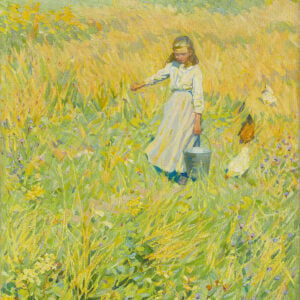
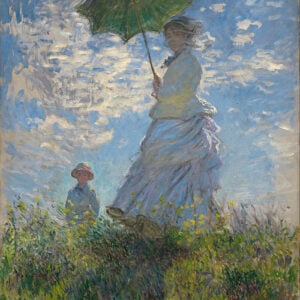
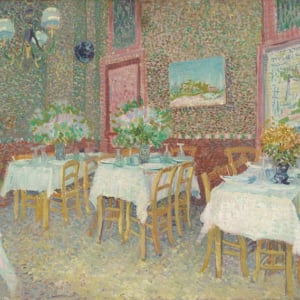

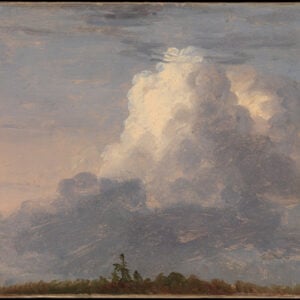
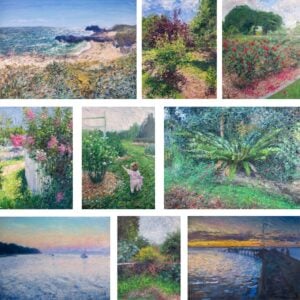
Thank you for all your information, I have soaked up every little detail and am so greatful to you.
I saw this beautiful painting many times, but now the tiles on the floor for the first time!
Very interesting what you told about het melkmeisje van Vermeer.
About the special blue paint o.a. and all the details of the painting.
In August I have planned
a visit to the Rijksmuseum in Amsterdam.
I’ll look in a different way than I should when I did’n read your “lesson” today.
Thans you so much!
Bonjour
Je trouve très intéressant, ce travail sur la peinture de Vermeer j’envisageais et encore aujourd’hui de peindre la laitière, j’ai peint il y a quelques années la jeune fille à la perle.
Merci pour ces informations
Absolutely lovely this painting…I really enjoyed your analysis of the painting and
thank you for all your tips..So helpful to absorb all this information. I find it
overwhelming when I start a painting but grow into it!
Nice points of interest. I enjoyed re learning about this painting from a fresh perspective. Thank you for this.
Fantastic ! Interesting and useful . One if my all time favourite paintings
Thank you for using paintings to illustrate the principles that will help us in our paintings. You are good at teaching. Great article.
I look forward to your posts and have either learned or have been reminded of many painting techniques . I love Vermeer’s work. Amazing master painter.
Thank you very much!
Thank you very much for this information found it very interesting it helped me to improve my powers of observation
Definitely!
You have given me yet another art lesson for my students. Many of the vocabulary words are great and will apply to other art lessons. Your wisdoms saves me time and hard investigative work. My many thanks!!!!!
I appreciate your knowledge and expertise in using certain paintings to illustrate various techniques and composition used by master classic artists. I especially liked the opportunity to see the painting in high definition to see and understand clearly all the principles you were pointing out in regards to this painting. As stated before, you are an excellent teacher. I look forward to you posts. Thanks so much.
Thank you for such a detailed analysis of this painting! I keep a little reproduction of it on my fridge, a memento of my visit to the Rikjsmuseum about ten years ago. This painting has so many delicate and subtle features, and you were able to point these out. I love your postings, you have inspired me to resume my oil painting after a long break. Thanks again.
Thank you forever so much for opening a door to art in my life.
Thank you for all the tips. This lesson has been very valuable to me. I really appreciate you in the heartfelt sharing that you do for us. There is so much importance in the fundamentals of art. There are many people who are true artists but not quite as many that can teach in a way that is understood by many. You are that teacher!
Thanks again for the insights. Reminds me of my Northern Renaissance art history class….but without an exam!
You always offer the reader a ‘different eye’ , and it is also reassuring to hear that the masters used the technology and science of the day to plan and execute their paintings.
I was fortunate to see this painting in person. I wish I had read this first.
Same. And I wish I had photo’d it in great detail like the examples above. Would have helped greatly to see the individual brushstrokes.
I so enjoy your description of the art you show us. It helps me realize the different techniques!
Thank you, thank you!
My partner and I both talked about this painting as we are driving along the road . Me reading your notes to him. Thanks for your notes on the painting.
Thank you for the informative analysis, very interesting. I love the fact he painted over the map , although it scares me in a way that they have the tech to be able to see our errors lol. Breaks my heart when seeing the painting close up to see all those cracks, I suppose only the test of time will show if our paintings survive unblemished.
so much to learn each time. Thank you!!
A couple of years ago I was lucky enough to see this original paingint in the Rijksmuseum. That museum is filled with so many masterful paintings that it’s truly overwhelming. The photos I obtained! And, we had a guide with us the whole way who explained them in great detail.
But you covered precisely what I needed to know about this particular one. Thanks for the heads up! You’re the best.
A couple of years ago I was lucky enough to see this original painting in the Rijksmuseum. That museum is filled with so many masterful paintings that it’s truly overwhelming. The photos I obtained! And, we had a guide with us the whole way who explained them in great detail.
But you covered precisely what I needed to know about this particular one. Thanks for the heads up! You’re the best.
l disagree with you about the camera obscura. l believe the theory that artists use and have used every device they can to achieve their objective. They would be stupid not too. Like a carpenter using one hand to set the nail and then the same one to pound it.
Hi Thomas. I actually agree with you. I just thought it was worth mentioning.
Thanks!
Thank you for your insight, Dan.
Keep the reviews of famous paintings coming; hopefully, it will help me with my own work
Thank you so much, Dan. I find your discussions very informative and valuable. Regards, Jennie Olls
I feel like she’s a friend telling me something confidential. Very warm feeling , I may paint her.
Thanks for all the details.
Anne-Marie WHitehouse
Very illuminating information.
Thanks,
Ces Manas
Sooo interesting – thank you for much for sharing your knowledge and insights to this magnificent piece!
Barbara , Baja California, Mexico
Nov 14th, 2019
I am VERY convinced of the camera obscura point of view. He could have used a v. point to make sure he aligned everything okay even using the pin hole or class. I know I would!
Vermeer’s The Art of Painting is full of guiding lines. I can show you.
thank you, very helpful information. These are points I would have never noticed before.
I love this painting. I saw this in Amsterdam a few years ago and it’s stunning. I didn’t have the background I do now after reading this post. I’m loving these tastes of art history.
Thank you for sharing your observations. They’re very helpful and add a rich understanding to each work.
I’ve really been enjoying all your posts and the comments.
I wonder what happened in the space just under her right arm….. it seems like the colour and quality of this small area doesn’t match the quality of the rest of the painting.
What do you think Dan?
I noticed that too, for years I hadn’t found any reasonable explanation of that.
Look at the right arm and the area around it, I believe Vermeer drew this piece very hesitantly. In some of his later paitings, the forward held arms were drawn more firmly and smoothly.